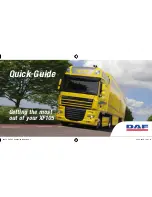
decrease load on the drive axles and will
decrease traction. Decreasing pressure will
transfer more weight to the drive axles and
will result in more traction from the drive
axles.
Deflate the auxiliary axle suspension
before coupling or uncoupling a trailer.
After the trailer is coupled or uncoupled,
then increase pressure to balance traction
and axle load requirements. Inflate air
springs of the auxiliary axles to the desired
pressure after coupling to a loaded trailer
while still maintaining proper traction of the
drive axles.
Adjust the pressure regulator control knob
to a lower pressure until desired traction is
obtained. By reducing air pressure at
pusher or tag axle, load will be transferred
to drive axles. Do not overload drive axles.
Always deflate air springs of the auxiliary
axles before attempting to unload vehicle.
This allows maximum traction of the drive
axles to control the vehicle.
Depending on the suspension, various
calibrations may be required. Contact your
authorized dealer or axle/suspension
manufacturer for specific calibration
procedures.
Some suspensions require dump valve
calibration. For example, some dead axles
do not lift, but the air can be dumped out of
them to unload them when empty. Air
pressure is controlled via an adjustable
regulator. These axles need to be
calibrated for load.
Contact your authorized dealer or axle/
suspension manufacturer for dump valve
calibration procedures.
Axle Creep Rating
Vehicles outfitted with auxiliary axles and
full truck configuration will have an axle
creep rating which defines how much load
is allowed when the vehicle has a full load
and maneuvering the vehicle, at very slow
speeds, with auxiliary axles in the up
position. In these situations, the load
exceeds the gross axle weight rating of the
axles.
Operator's using vehicles equipped with
liftable auxiliary axles must consider creep
ratings when any liftable axle is unloaded
or in the raised position. Liftable auxiliary
axles should only be raised (or unloaded)
to improve maneuverability in an off-road
use or when vehicle is unloaded.
WARNING
NEVER operate the vehicle with more
pressure in the lift axles than is neces-
sary to carry the load, as determined
by the calibration procedure described.
Failure to do so can result in loss of
traction and stability at the steer and/or
drive axles and can result in increased
braking distance, which could cause
loss of vehicle control resulting in an
accident. Failure to comply may result
in death, personal injury, equipment or
property damage.
NOTE
Axle Creep ratings MUST NOT be ex-
ceeded.
CAUTION
Always lower the axles as soon as
possible after receiving a load. Never
exceed 5 mph (8 km/h) when driving
with a load with the auxiliary axle(s)
raised/unloaded. Failure to lower the
axle(s) can overload the frame and re-
maining axles, and could cause equip-
ment damage.
DRIVING - Axle and Suspension
Y53-6126-1A1 (01/21)
173
4
Содержание Peterbilt 567 2021
Страница 1: ...567 M O D E L ...
Страница 2: ......
Страница 3: ...Safety 1 Emergency 2 Controls 3 Driving 4 Maintenance 5 Information 6 Contents ...
Страница 5: ......
Страница 7: ...Daily Checks 35 Weekly Checks 36 Systems Check 37 SAFETY Y53 6126 1A1 01 21 5 1 ...
Страница 41: ...SAFETY Systems Check Y53 6126 1A1 01 21 39 1 ...
Страница 63: ...1 Additional Switches 2 Ignition Switch CONTROLS Instrument Cluster Y53 6126 1A1 01 21 61 3 ...
Страница 131: ...CONTROLS Cab Accessories Y53 6126 1A1 01 21 129 3 ...
Страница 331: ......



































